10 Best Project Management Software for Startups: Find Your 2025 Task Tracker
If you’re looking for the best project management software for startups, rest assured there are several options designed to help you keep track of your team and company growth. Here’s our list of the most popular apps to help small businesses succeed.
Startups involve a lot of trial and error. Things can get chaotic, and managing the mess can be challenging. Finding the best project management software for startups is essential for building a streamlined structure that enables smoother operations and collaborations. Lucky for you, our experts reviewed dozens of project management tools to bring you this handy-dandy list.
This article breaks down the crucial features that must be present in any project management solution for startups and SMBs, and offers you the insights you need to make a smart decision. If you’re low on time, monday.com is our top choice, but there are plenty of good options included here. Alternatively, check out our best project management software roundup for a broader look at our experts’ favorites.
-
06/07/2024
Updated the article to reflect monday.com’s latest pricing information.
The Top PM Apps for Startups
- 1
- 2
- 3
- 4
- 5
- 6$10 / month(All Plans)
- 7
- 8$15 / month(All Plans)
- 9
- 10
How to Choose the Best Project Management Software for Startups
Selecting the right project management tool is crucial for startup success, and various factors must be considered. Budget constraints often dictate choices, especially for bootstrapped companies. Well-funded businesses can opt for more feature-rich software.
Key considerations include communication and collaboration tools, such as group chats and task assignment features, as well as integrations with commonly used apps like Gmail and Google Drive. Scalability is another vital aspect, as the software should grow with the business. Our top recommendations for startups include monday.com, ClickUp, Asana, Freedcamp, and Trello. Each offers unique advantages, from flexible feature sets to specific project management methodologies like kanban and Gantt charts.
Avoid Costly Project Management Mistakes – Get Free Tips Today!

- Discover 10 fundamentals of project management
- Understand step-by-step plans for PM execution
- Learn tips to avoid 5 common mistakes by beginners
- Budget Consideration: The financial status of a startup, whether bootstrapped or well-funded, influences the choice of project management software.
- Communication and Collaboration: Features like group chat and task assignments are essential for remote teams and efficient workflow.
- Software Integration: Compatibility with popular third-party apps, such as Gmail and Google Drive, is important for seamless operations.
- Scalability: The software must be capable of handling business growth and evolving project management needs.
- Unique Methodologies: Each recommended tool offers distinct approaches, from kanban and Gantt charts to communication-centric models.
The Top 10 Project and Task Management Tools for Startups
Now that you know what to look for in project management software for startups, here are our top recommendations that you can start using today.
1. monday.com
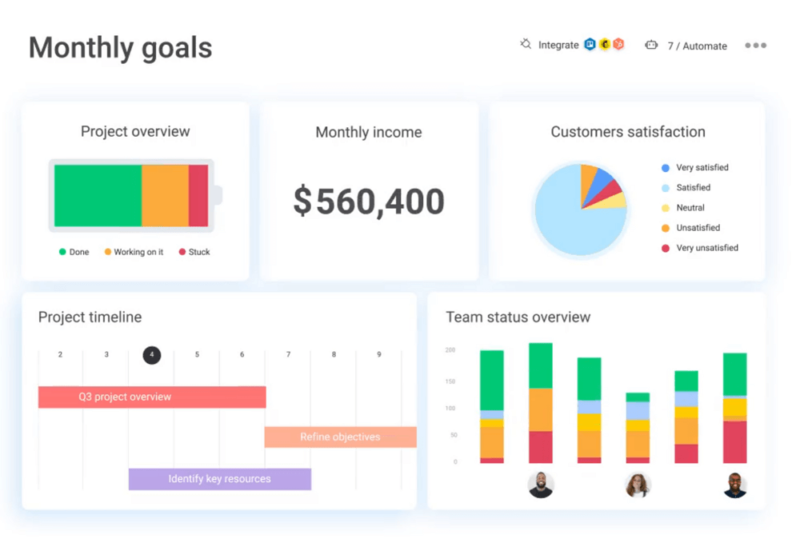
More details about monday.com:
- Pricing: Free plan available with up to 2 seats; Basic plan for $9 per seat per month, billed annually
- Provider website: monday.com
Pros:
- Easy to use
- Secure
- Lots of integrations
Cons:
- Very limited free plan
- Odd progress on paid plans
monday.com is a collaborative platform for startups that focuses on business operations, team management and project visibility. It’s the best web project management software and can be used by businesses of any kind and size, from small startups to large enterprises, making it a very scalable solution.
The platform comes packed with features that make it a more holistic solution, including task management, document collaboration, automations and shared timelines. Despite being feature-packed, monday.com is still an easy-to-use project management software.
Running a successful startup requires a lot of planning and visualizing of future processes. monday.com makes it easy to map your company’s workflow from ideation to delivery, so every team member has a clear vision of where they fit. With all these features on one platform, you don’t need another system for communication or project management.
An All-in-One Project Management Solution
Smaller startups, as well as larger ones with a distributed workforce, can use monday.com to streamline workflow, increase transparency and collaboration and improve productivity. It’s easy to see why.
The monday.com platform allows projects to be organized around tasks, documentation and conversations, rather than siloing them into separate groups, allowing for more fluid communication between departments. It goes beyond project management to provide a unified workspace across functions.
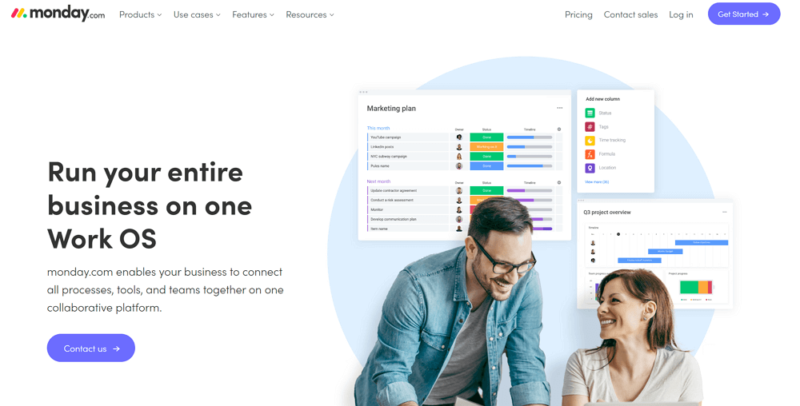
With monday.com’s free plan, you get just two seats, a limit of 1,000 tasks and access to the list view and kanban board. This won’t be sufficient for most startups, so it’s best to opt for the paid plans. These provide more project views, access to automation features and unlimited tasks.
You can give the 14-day trial a chance before committing to the paid plans. Check out our monday.com review.
- Maximum users: 2
- Minimum users: 3; All prices per user
- Minimum users: 3; All prices per user
More plans
- Minimum users: 3; All prices per user
- Enterprise-level features.
2. ClickUp
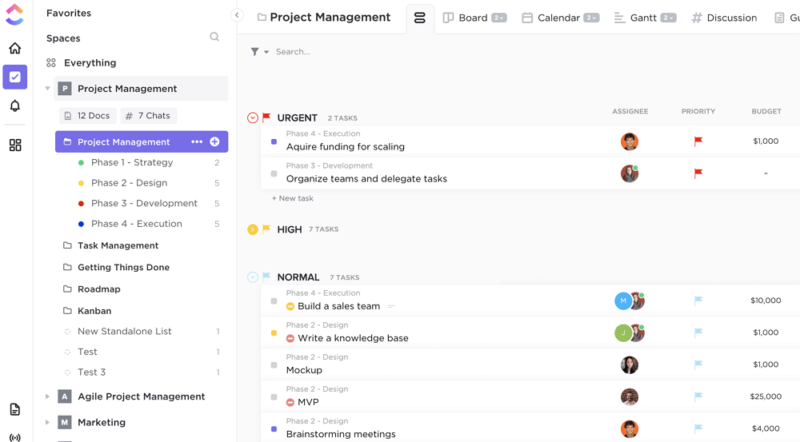
More details about ClickUp:
- Pricing: Free plan available with cap of 100MB storage; paid plans start at $5 per member per month, billed annually
- Provider website: clickup.com
Pros:
- Cheap plans
- Unlimited storage on paid plans
- Project templates
Cons:
- Lags when moving tasks
- Some features not fleshed out
- Sloppy documentation
ClickUp is a feature-rich, reasonably priced project management tool. Startups can make good use of its task management views, which include Gantt charts, calendars and a space for notes.
There is also a mind map integration, a feature not found in many other project management solutions. You can produce mind maps, then transform them into tasks and give the tasks to the team as kanban boards. This helps visualize work and maximize efficiency.
A Power-packed Free Plan
Typically, project management services provide a limited number of views and features in their free edition, hiding the rest behind a paywall. ClickUp provides a complete task-tracking suite, only restricting how often you may use it, with a cap of 100 uses on the free plan.
You can set up recurring tasks, create an unlimited number of projects and use all of its reporting tools, enabling better supervision of weekly and monthly targets. Read our full ClickUp vs monday.com guide to learn how our top picks compare.
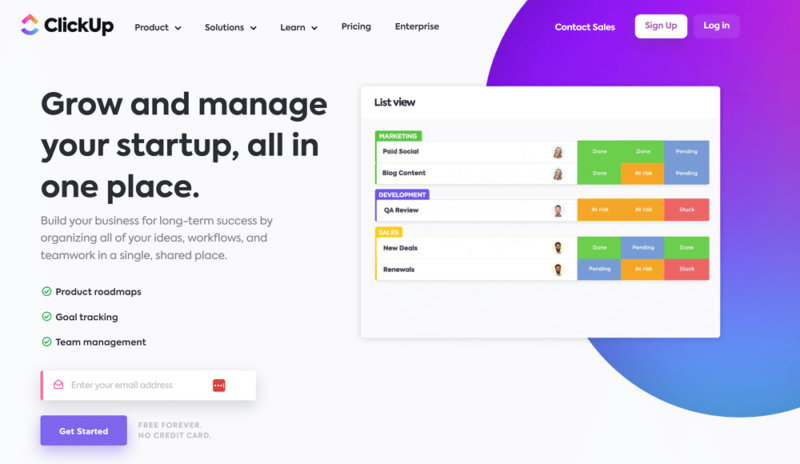
The only distinction of the paid plans is users get extra storage space and sophisticated security features. While the free plan has a lot to offer, the paid and advanced plans are also highly affordable. If you’re still feeling skeptical, you can try a 30-day free trial to test ClickUp’s advanced features or read our ClickUp review.
- Basic functionality with some limitations
- All prices per user
- All prices per user
3. Asana
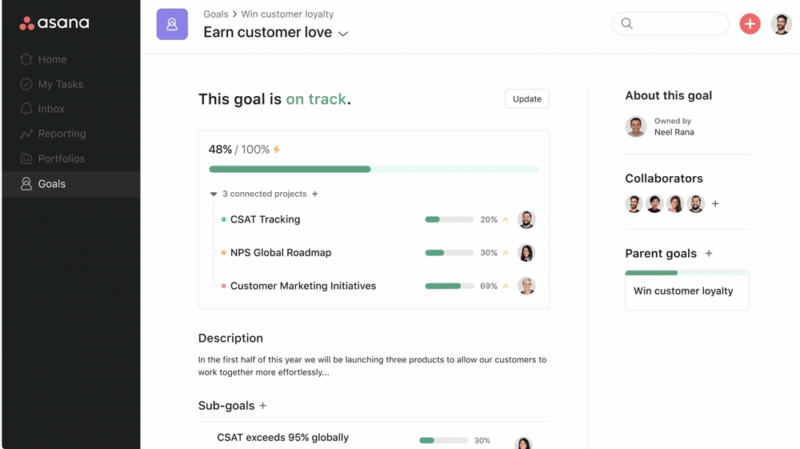
More details about Asana:
- Pricing: Lifetime free plan for 15 members; Premium plan starts at $10.99 per user per month, billed annually
- Provider website: asana.com
Pros:
- User-friendly & versatile
- Many features & integrations
- Lots of views available
Cons:
- A little expensive
- No customer service available
- Mediocre security options
If you are looking for a free plan that allows you to manage projects for a small team, Asana might be the right choice for you. Even small teams can take advantage of the functionalities Asana provides, which include unlimited tasks, projects and messages; list, board and calendar views; and 100 free integrations with apps of your choice.
It offers features for long-term and short-term tasks. The workload view has a self-generating progress meter that lets you quickly identify who is doing what and determine whether employees are working too much or too little.
The software also offers dashboards for a simplified overview, project reports and customizable charts, as well as more user management and timeline options.
Task Automation and Integrations With Asana
Task automation allows you to set rules for your tasks, so actions are automatically taken when something happens (such as a team member commenting on a post). When your automations work, you can get updates through email or mobile notifications. Asana’s third-party integrations are useful, too.
With just one click, you can connect your project management tool to Gmail, Salesforce, Dropbox and more.
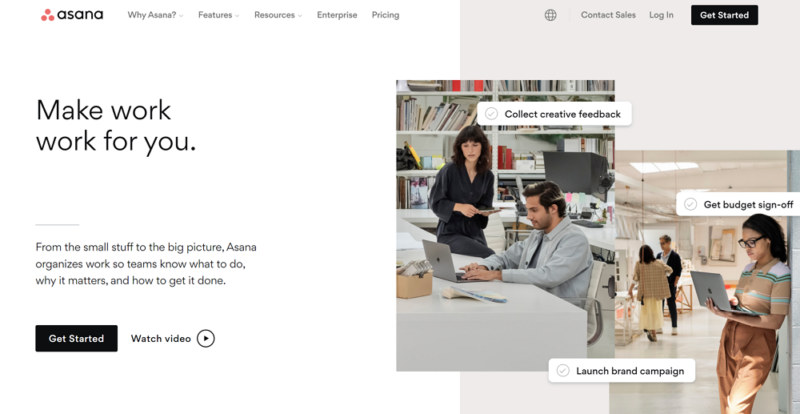
While Asana provides a solid set of project management features in the free plan, some of its more useful features are locked behind its paid plans. However, the free plan does provide up to 15 users with a calendar view and unlimited tasks and projects, making it a great ClickUp alternative. You can start with a 30-day free trial to test the paid plans.
Check out our Asana review to learn more.
- Up to 10 users
- Price is per user. unlimited users, expanded features
- Price is per user. unlimited users, even more features
- Custom pricing, advanced security features
4. Freedcamp
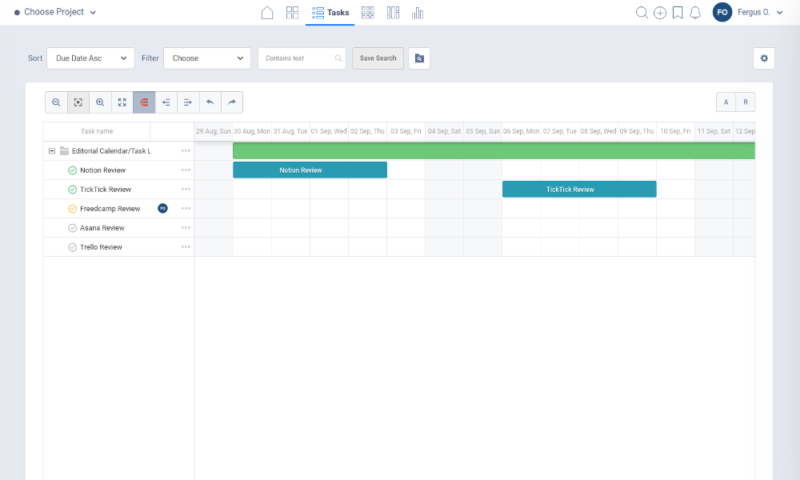
More details about Freedcamp:
- Pricing: Free plan available, paid plans starting at $2.49, billed monthly
- Provider website: freedcamp.com
Pros:
- Unlimited users & projects on free plan
- Good feature set
- Affordable paid plans
Cons:
- Slow response time
- Overly simplistic features
Freedcamp is another great, affordable option, offering a range of plans focusing on workflow automation. It is user-friendly and lets you view and manage multiple projects easily through its “projects” tab.
Freedcamp also makes sure you can access your data at any time with its sync feature, which means you can work on projects across multiple devices. Freedcamp offers a free plan with no user cap, making it an ideal choice for startups with large teams.
However, if you want features like Gantt charts, you need to opt for a Business plan. While this plan provides top project management features, it’s still just good. Competitors like TeamGantt take a way better approach.
Go Beyond Task Management With Freedcamp
Freedcamp’s calendar integrates a timeline feature with the standard calendar that most project management applications offer. You may get an excellent overview of how your week or month is going with this handy tool. If you want to opt for the paid plans and use Google Workspace extensively, you can also leverage the Google Calendar Sync.
In addition to these, Freedcamp provides a number of free integrations and add-ons, like basic password managers, time-tracking tools for projects, milestone setting tools and tools for integrating communications.

Freedcamp offers free and cheap paid plans. One huge plus in the free plan is unlimited users, projects and storage. The more advanced paid plans add features like the wiki, issue tracker and reports. The 14-day free trial lets you try them. You can sneak a peek at our Freedcamp review to get a deeper insight.
- Unlimited users, Unlimited projects, Basic functions
- Price per user, Storage integration, Table view
- Price per user, Templates, Gantt charts, Custom fields
- Price per user, Security options, 14-day trial
5. Trello
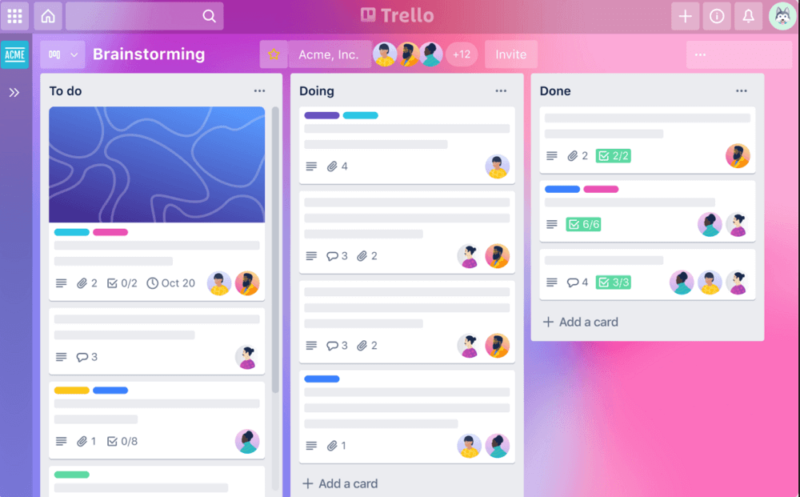
More details about Trello:
- Pricing: Free plan available with a file size cap of 10MB; Standard plan at $5 per user per month, billed annually
- Provider website: trello.com
Pros:
- User-friendly
- Great free plan
- Versatile kanban tool
Cons:
- Paid plans aren’t feature-rich
- Highly reliant on integrations
Trello offers you the best kanban tool you can get from a project management software with a free plan. The platform lets you manage simple and complex tasks and acts as a hub for project management strategies. It offers a clean visual overview of projects, organized through a board and card-based approach that can help you monitor their progress at a glance.
Each card on Trello’s kanban board represents a job and may be customized with a variety of items. You can add as many columns as you like. That combined with a seamless user experience makes this a tool any startup can pick up immediately.
Get Workflow Automation With Trello
Trello is user-friendly and straightforward, and the free plan is sufficient for tiny teams that can get by with kanban-based graphic styles. It allows for unlimited integrations and power-ups, allowing you to use it as the central hub for all of your project management techniques.
However, without any of these power-ups enabled, Trello’s usefulness is limited to personal to-do lists and collaborating on projects within an organization. Its core strengths lie in its integrations.
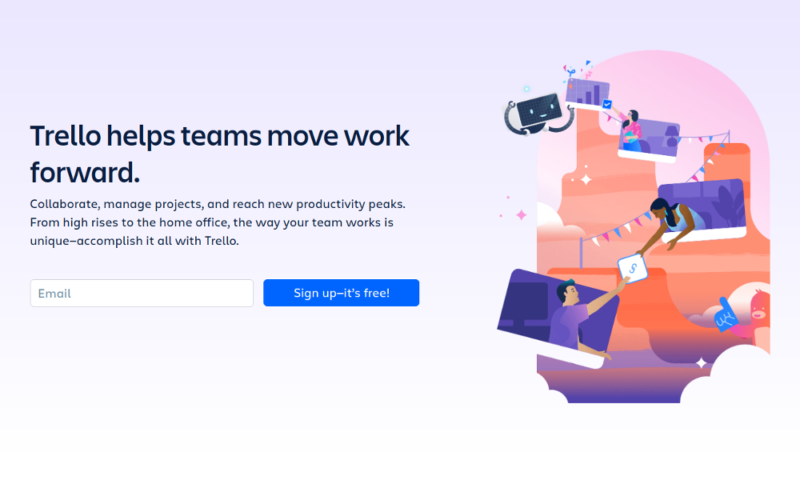
Trello’s free plan is a good option for startups to kick off with, as it offers unlimited users and integrations. However, there’s a limit of 10 boards per workspace and a 10MB file size upload limit, so those who want to scale should opt for the paid plans.
Read more in this Trello review. You can also read our ClickUp vs Trello comparison to learn how Trello compares to one of the best project management tools.
- Unlimited users, 10 boards, Unlimited power-ups, Unlimited storage
- Price is per user, Unlimited boards, Custom fields, Invite guests
- Price is per user, Several new views
- Price is per user, Advanced admin & security settings
6. Wrike
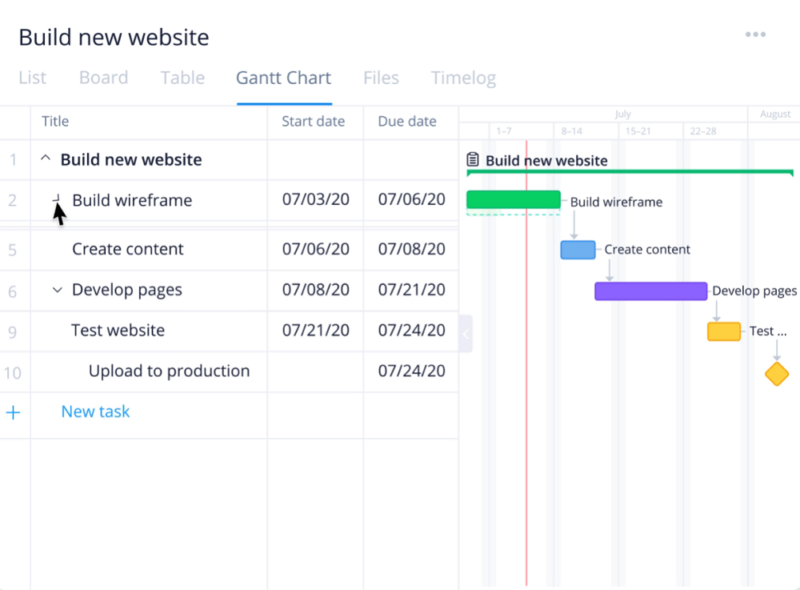
More details about Wrike:
- Pricing: Free plan with a cap of 2GB storage per account; Professional plan at $9.80 per user per month
- Provider website: wrike.com
Pros:
- User-friendly
- Good security features
- Free plan comes with support
Cons:
- Unreliable privacy policy
- Unspecific plan progression
- Interface isn’t too pleasing
Wrike is an easy-to-use, reasonably priced project management solution that’s a reliable Trello alternative. It does a fantastic job of combining several essential skills, making it a solid choice for both small- and large-scale teams. It accomplishes this using built-in integrations and its own add-ons (which other applications, like Trello, don’t offer).
The add-ons for Wrike may be added one at a time, but there are also bundles aimed at specific user categories, like marketing teams and professional services as well construction project managers. While it offers a good free plan, features like two-factor authentication are hidden behind its highest-tier paywall.
Other features like calendar and Gantt charts — which are even in the free plans offered by its competitors — are a paid feature with Wrike.
Get Something for Everyone With Wrike
Wrike is a full-suite project management software for a range of use cases, like task management, file management and reporting. If you’re willing to pay, you can even make use of resource scheduling and time tracking.
The way it works is simple: The user inputs data in the preferred format and Wrike takes care of organizing everything. Custom-made templates are also available to account admins on the paid plans for creating workflows or setting up automation features.
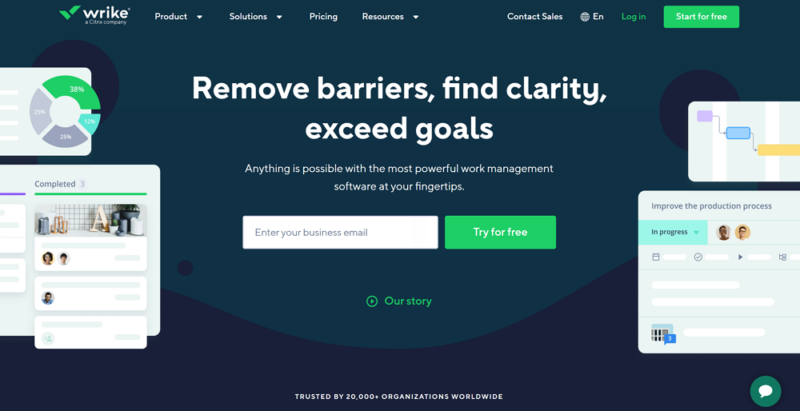
You get access to the interactive board, spreadsheet views and live activity feeds with Wrike’s free plan. You’ll need to subscribe to one of its paid plans if you want to use the interactive Gantt charts. To find out more, read our Wrike review.
- Unlimited users. Basic features.
- Price is per user. Plans for 5, 10 and 15 users.
- Price is per user. No monthly option. Plans for 5 to 200 users.
More plans
- For large teams; Enterprise-grade security and scalability; Plans for 5 to an unlimited number of users.
- For teams with complex work needs; Advanced tools and analytics for complex work; 5 to unlimited users
7. TeamGantt
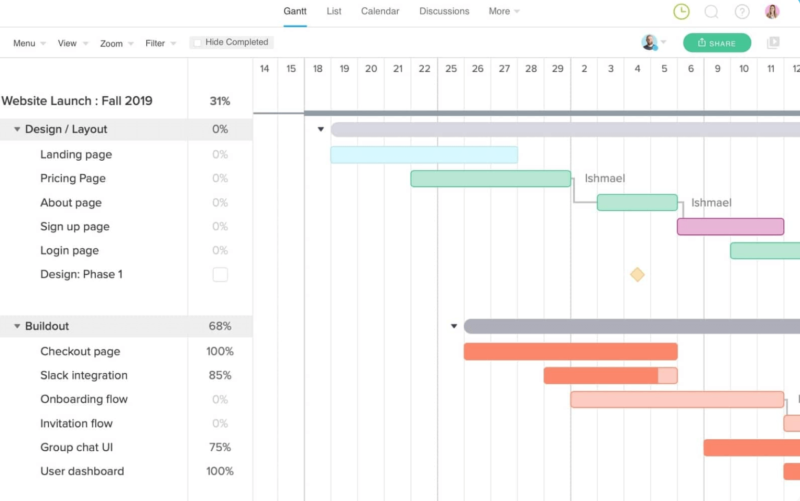
More details about TeamGantt:
- Pricing: Free plan available with a cap of 60 tasks; Lite plan at $19 per manager per month, billed annually
- Provider website: teamgantt.com
Pros:
- User-friendly
- Best free Gantt tool
- Offers good support
Cons:
- Less variety of features
- Lack of integrations
- 1 Gantt chart on free plan
As the name suggests, TeamGantt focuses on Gantt charts and is one of the best Gantt tools in the market. If Gantt charts are your go-to tool for project management, you can use this software to create them for free.
Due to its niche focus, TeamGantt offers few other features compared to competitors. It only offers kanban boards as an alternative view, available on the paid plan. Its limited views means it might lack the scope some startup teams might be looking for.
However, TeamGantt does integrate with Trello, Dropbox and Slack, expanding its functionality to some extent through these third-party apps.
Get the Best Gantt Charts With TeamGantt
TeamGantt has an intuitive system that lets you reorganize your projects with the click of a button, so you can adapt to new or unexpected changes when they happen. Its drag-and-drop function gives you the power to reorder tasks, view task dependencies and change milestones within your Gantt charts.
With other project management tools, it’s not as easy and subtask creation is required. Hence, the user-friendly interface makes TeamGantt optimal for first-time Gantt chart users.
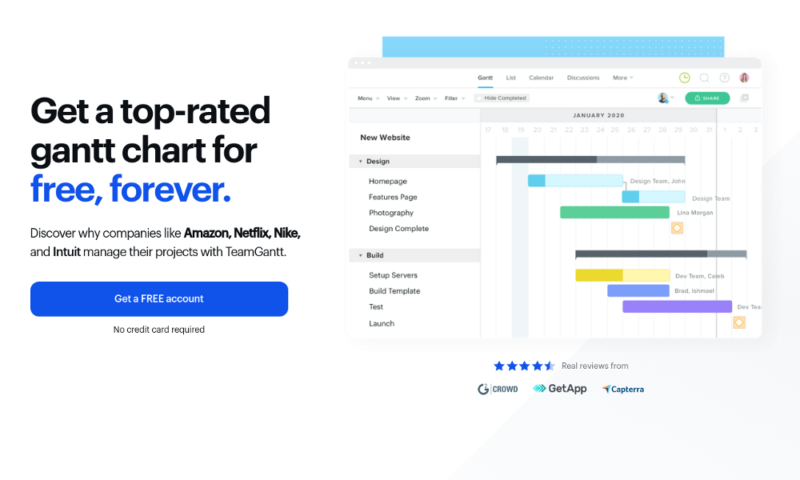
You must choose one of the subscription plans if you want to use more than one Gantt chart. With the free plan, you are only allowed one project manager and two collaborators, and your project can only have up to 60 tasks at a given time.
Read our TeamGantt review to learn more.
- 2 users (1 manager)
- Unlimited
- Unlimited
8. Basecamp
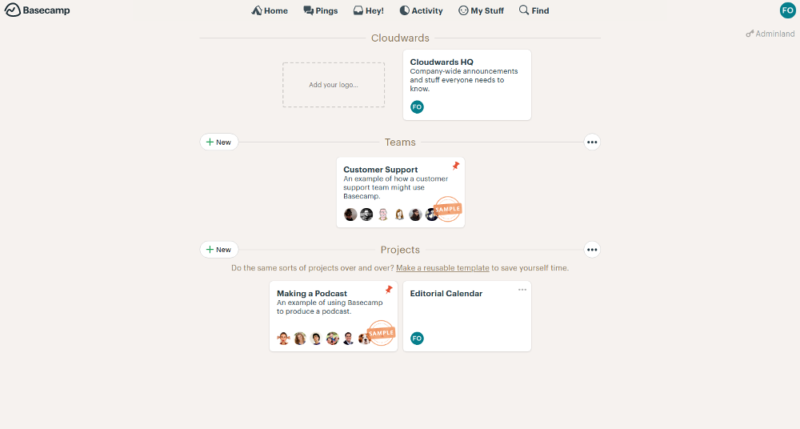
More details about Basecamp:
- Pricing: Free trial available; Paid plan at $99 per month
- Provider website: basecamp.com
Pros:
- Flat-rate paid plan
- Good for team communication
- Provides more oversight
Cons:
- Limited project management features
- Expensive for small teams
- UI is not very user-friendly
Basecamp is more of a communication app than a project management tool. This means it helps improve collaboration, and in turn, keeps project management in check for managers. As a communication-focused tool, Basecamp lets you manage and track each team member’s day with exceptional two-way communication.
However, it lacks project management-specific features, like the kanban boards and Gantt charts Asana and monday.com offer. Basecamp scales communication effectively and makes it simple to monitor daily tasks and schedules. See how it differs from one of the leading communication tools out there: Slack, in our Basecamp vs Slack guide.
It offers communication tools, such as message boards and to-dos, that teams can use to discuss issues and track progress.
Build Stronger Team Collaboration with Basecamp
Basecamp can segment your work into projects and break down project elements into facets like participants, conversations, documents, files, tasks, crucial dates and more. Each element can integrate with features like “schedule” (a calendar similar to any other) and “campfire” (a message board for casual conversation available on Basecamp 3).
Basecamp offers an “automatic check-ins” feature. This automates the stand-up meetings used in agile workplaces or the brief emails a manager might send to check in with their team. Basecamp also enables you to run a fast poll rather than calling the team together for a few brief updates on the status of their work.
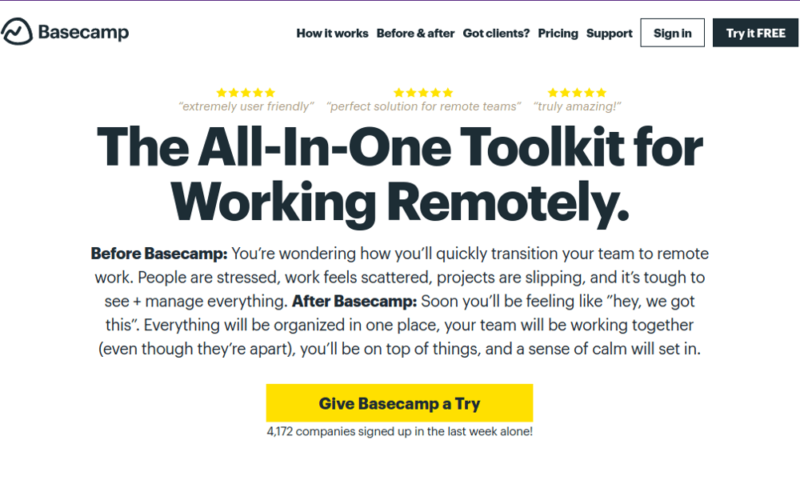
Basecamp offers two simple plans: one free and one paid. The free plan offers up to three projects, 20 users, and 1GB of storage space. The business plan is a one-time paid version with unlimited access to projects, users and clients. Check out our Basecamp review for more details.
- Per user. Unlimited projects, Unlimited users, All features. 500GB storage.
- Unlimited users. 5TB storage. Priority support.
9. Jira
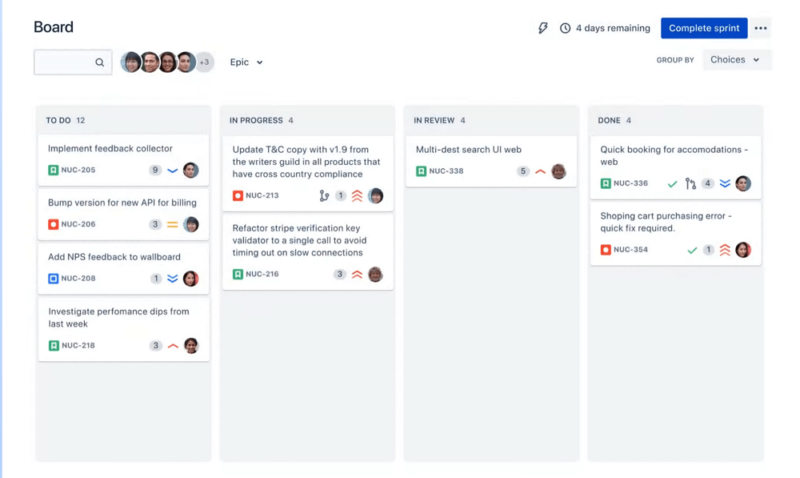
More details about Jira:
- Pricing: Free plan available for up to 10 users; Paid plans starting at $750, billed annually
- Provider website: jira.com
Pros:
- Affordable pricing
- User-friendly
- Best for software development
Cons:
- Not flexible
- Discount only after 100+ users
- Lots of jargon
Jira, Atlassian’s issue-management tool, has a lot to offer a tech startup or software development team. Small teams can use it to track progress on their projects and communicate with each other. Jira is most effective for software development teams who actively use Agile methodology. However, it has limited flexibility beyond this.
You can add fields to your “issues” (tasks) to capture everything from the status of your projects (in progress, waiting for someone else’s input, etc.) to what information you need for certain tasks (file attachments, notes from meetings and more).
Thanks to the vast number of paid integrations that it supports on the Atlassian Marketplace — such as Slack, Gantt charts, extra views, a bug-tracking tool and other useful task management apps — Jira can still be adopted for startups outside the tech space that also use agile practices.
It’s worth noting, though, that some of these integrations require payment.
Get a User-friendly Experience With Jira
Jira is easy to navigate, with a simple user interface and an extensive knowledgebase that has tutorials for new users. You can move quickly between screens thanks to its uncomplicated layout. Admittedly, it comes with a learning curve due to the unique technical jargon it uses.
You can check out Jira’s glossary to familiarize yourself. Once you get the hang of it, it’s one of the simplest tools out there.
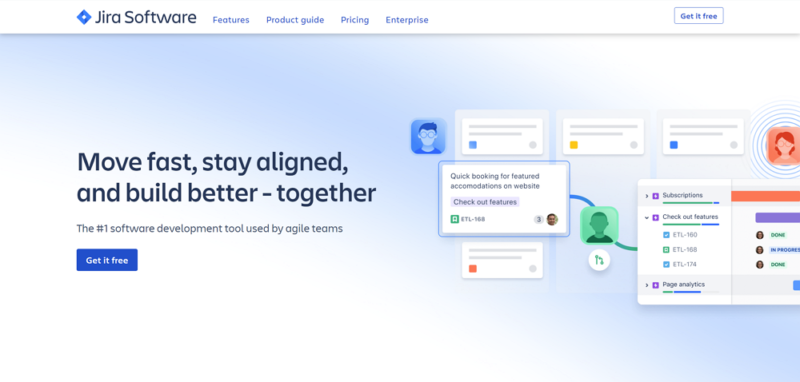
Jira is free if all you want to do is keep track of your most recent project tasks. However, paid plans offer some useful bonuses, such as advanced dependency management, global and multi-project automations and unlimited storage.
For small software development teams looking for an Agile-focused solution, Jira is a fantastic option, but be aware that the number of users you can have on this plan is capped at 10. Read our Jira review for more.
- Max. 10 users. unlimited boards, reports and insights; backlog; basic roadmaps; 2GB of storage; community support
- Monthly pricing starts from 11 users, pricing changes based on the number of users. Monthly pricing changes with teams over 110. Annual pricing shown is for 1-10 users
- Monthly pricing starts from 11 users, pricing changes based on the number of users. Monthly pricing changes with teams over 114. Annual pricing shown is for 1-10 users
- Enterprise plan pricing is available when you enter 801 or more users above; User tier: 801 - 1,000
10. nTask
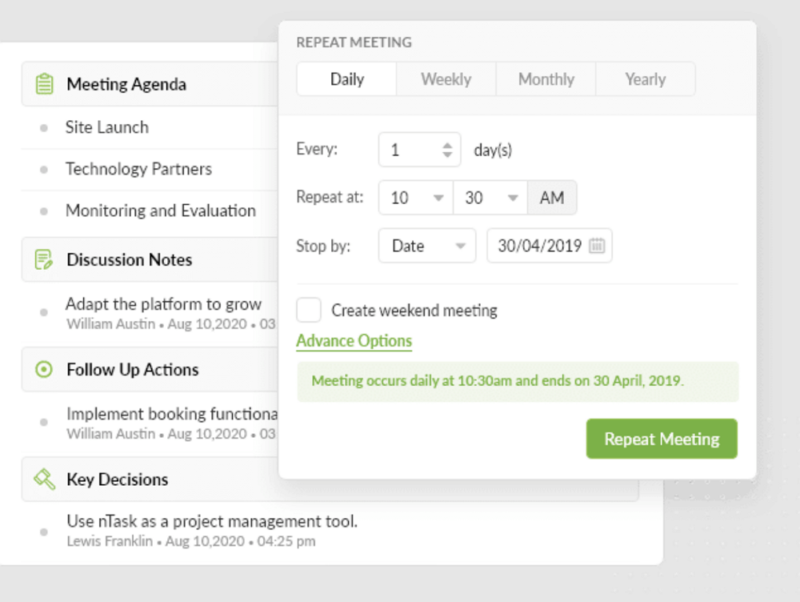
More details about nTask:
- Pricing: Lifetime free plan for 5 members; Premium plan at $3 per month, billed annually
- Provider website: ntaskmanager.com
Pros:
- Solid free plan
- Affordable prices
- Variety of features
Cons:
- Unreliable in terms of privacy
- Self-hosting only on paid plans
- Navigation can get annoying
nTask is one of the cheapest project management software solutions and offers the most value for money. It focuses on the main features of task management and delivers a user-friendly experience. You can assign tasks, track your task status and more.
Due to its solid foundation and flexible pricing, nTask is a solid choice for startups. It also offers project management views like Gantt charts, time tracking, kanban boards and more. It’s also worth noting that except for the time tracking feature, the others are not available in the free plan.
Get Agile Project Management With nTask
nTask combines the main elements of project management software with task management features. You can visualize tasks in relation to one another using the Gantt chart, which also has special capabilities like critical path analysis and risk assessment.
nTask also makes it easier to assign urgent tasks to users and manage task history, all in one place.
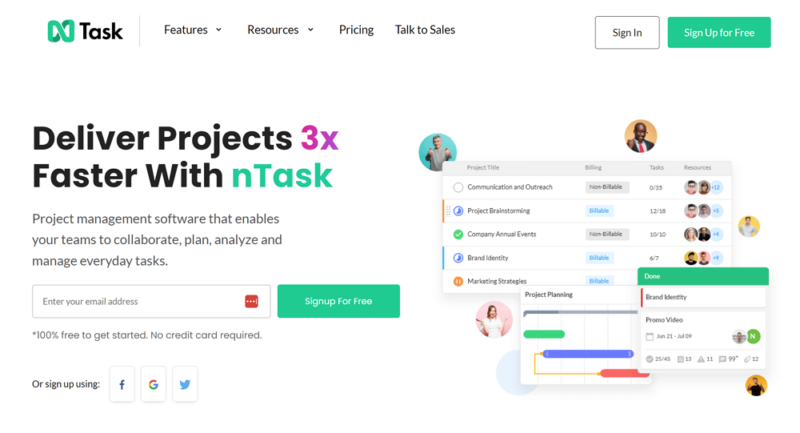
nTask offers a free plan called the Basic Plan which is free forever for up to 5 users, offering unlimited tasks and access to meetings. The difference between the paid plans is their storage limits, with Premium offering 5GB and Business at 10GB. You can give the seven-day free trial a shot before signing up for a paid plan.
Read more about nTask in our nTask review.
- Maximum 5 team members.
- No minimum or maximum team members.
- No minimum or maximum team members.
- Self-hosted option. 50 team members minimum.
Final Thoughts
Most startups have stricter budgets and a finance-conscious approach. This makes free project management software like monday.com, ClickUp, Asana and Freedcamp a good match. Read our ClickUp vs Asana comparison guide to learn how the project management tools compare.
However, the other options in this post are also worth considering. It’s important you first define your needs and determine what you expect. The best software for you must fit within your budget and cover all the essentials for your startup’s day-to-day needs.
What is your favorite project management software for small business? Are you using one that isn’t covered in this list, but you feel deserves a shout-out? Let us know in the comments. As always, thank you for reading.
FAQ
Project managers are essential to the growth of startups. They help ensure that the business embarks on projects that align with its goals, timelines are on schedule and there is effective communication within the teams.
Project planning involves identifying stakeholder needs, outlining goals, defining the responsibilities of teammates and scheduling milestones for its effective implementation. Project management scheduling software can help achieve this.
The most popular project management software types are resource management software, timeline management software, scheduling software and team collaboration software.


